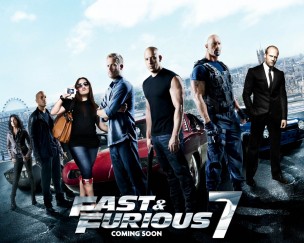It begins with the Fred Astaire and Ginger Rogers films of the 1930s. These musicals revolved around spectacle. There are conflicts and impediments in the development of Astaire’s and Rogers’ relationship, but what you’re waiting for—what you came to see—is “Pick Yourself Up,” or “Waltz in Swing Time,” the flight-of-fancy music numbers. These moments transcend time, space, and logic to reflect pure visceral emotion, leaving you transfixed and even exhausted.
This is ultimately the aesthetic Vin Diesel and Jason Statham emulate when they grab wrenches and metal rods and ram into each other like bulls. These men encourage a gratifying sensation, on some basic elemental level, that leaves us thirsty for blood. “Furious Seven” taps into our desire for soaring, acrobatic violence. Director James Wan (“The Conjuring”) swaps in for Justin Lin (director of franchise’s previous three installments), but structurally the film is the same as its predecessors. The names have changed, nothing else: Jason Statham’s Deckard Shaw swaps in for Luke Evans’ Owen Shaw as the big baddie, stopping at literally nothing to avenge his brother and take out our beloved crew.
Screenwriter Chris Morgan and team have gradually pushed the “Fast & Furious” franchise from a bunch of street racing movies to James Bond levels of insanity. Kurt Russell join this series. His character Petty is responsible for ushering Diesel and family out into the world to retrieve the kind of device only available in movies: the God’s Eye, which allows its user to somehow use every piece of machinery on the planet to spy on anyone at any time. It’s utterly bonkers and exists mostly to let our crew hop across the globe, from the Caucasus Mountains to Abu Dhabi to an anonymous factory. Russell himself is gloriously wry in this film; he banters with Diesel about his propensity towards Belgian ale, though Diesel, a more commercial kind of fellow, demands his Corona Extra. Russell obliges by whipping out an ice-cold bucket of his favorite beer. It’s the cutest product placement you’ve ever seen for an alcoholic beverage.
The plot for “Furious Seven” doesn’t actually take up much screentime. It’s easy to get the gist a few minutes in: these people talk a lot about family and loyalty in between chases, heists, and fistfights. Early in the movie, the team skydives in their car and then has a chase on a winding, windy mountain road. It’s an incredible set piece, where the action is precise and beats telling a coherent, gripping story. When it comes to action choreography, the “Furious” franchise commits like no other. Wan commands the frame and keeps the camera moving while still focusing on the coherence of the action. I was left gasping for air at each sequence, which makes it easy to forget how silly everything is. Jason Statham inexplicably shows up near the end of every action sequence, and if you can accept that, you’ll probably be content with the structure of the film. This installment is particularly Dom-heavy, which simultaneously caters to the franchise’s development of Vin Diesel as a superhero who spews pulp poetry as he rides cars alongside beaches or camels. He is a huge contributor to a dopey sense of fun, as is the Rock, of course. Few other actors could bark, “Woman, I am the cavalry!” as they walk towards a drone blasting a machine gun and absolutely sell it.
Not everything is peaches in “Furious”-land, however. Wan’s film feels particularly less interested in its female characters: the two women are primarily romantic interests, and there are glimpses of anonymous bikini-clad extras shot all-too-lovingly, which was not a major component of the Justin Lin “Fast & Furious” films. In Abu Dhabi, Tyrese Gibson sits at a cabana and admires women from afar. Lety (Michelle Rodriguez) calls him out on his foolishness, but the deed is done, and even a quick fistfight in the next action sequence between Rodriguez and Ronda Roussy in a lavish Abu Dabi hotel room doesn’t help the sensation that the women in this world are largely objects to be exploited. Future installments could work on this issue further, but the “Fast” franchise must be commended for its long-running commitment to diversity: Diesel is the last person on the team who could be white (the actor has stated he is of “ambiguous ethnicity”).
For all its ridiculousness, there is a real-world underpinning to the story of Brian (Paul Walker) in the film, where “Furious Seven” offers its most interesting emotional discourse. Walker died in the middle of filming, and for the final product Universal used a mixture of body stand-ins and CGI components to recreate Walker’s face and body. Most of the audience for this movie will be well aware of Walker’s passing, but because the studio elected to keep his unfinished work in the film, the end result for Walker’s character is wholly unexpected. I was constantly questioning when Walker would leave the film, and the answer truly caught me off guard. The series has run its family themes into the ground by this point, but in the wake of a beloved team member leaving, those themes became vital again.
At the end of the day, the cars come first. Cars fall out of the sky and parachute into nothingness. Cars crash out of windows and soar between the tallest buildings in the world. “Vroom vroom,” they go, and the audience gasps with a barbaric yawp, their engines humming alongside the magic flying vehicles. Cars tumble down mountains, with Diesel, our gelatinous cube of a man, exiting unharmed. This is pretty much what Astaire and Rogers promised us generations ago. Few sensations in the medium could please me more.
